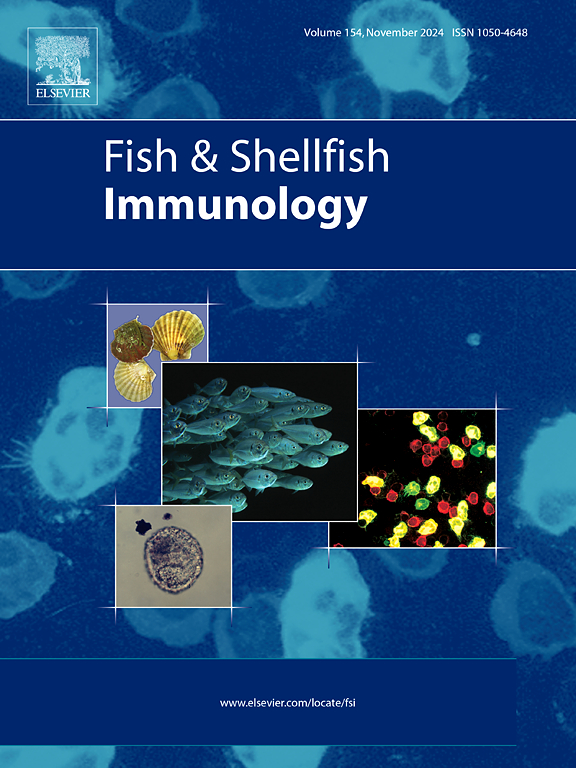Lipid metabolism and immune crosstalk in fish gut-liver axis: Insights from SOCS8 knockout and dietary stress models
IF 3.9
2区 农林科学
Q1 FISHERIES
引用次数: 0
Abstract
Metaflammation, a chronic immune response triggered by metabolic dysregulation, poses significant threats to gut-liver homeostasis in aquaculture species. To understand the progression of metaflammation, it is crucial to examine the role of SOCS8 deficiency in socs8−/− zebrafish, as this species may serve as a disease model for metabolic disorders due to the gradual dysregulation of immunity, metabolism, and the gut microbiota observed in them. This study examines the immune-metabolic crosstalk in grass carp, subjected to soybean meal-induced enteritis, and in socs8−/− zebrafish under genetic and dietary stress. SOCS8 is a negative regulator of cytokine signaling via the JAK/STAT pathway; its deficiency mirrors the persistent inflammatory and insulin-resistant states commonly seen in carnivorous fish-fed high-soybean diets, making it a valuable model for studying diet-induced metaflammation. Weighted gene co-expression network analysis (WGCNA), differential expression profiling, and immune cell infiltration analysis revealed that grass carp respond to dietary stress with disrupted glucose and lipid metabolism, activating MAPK, NF-κB, and NOD-like receptor pathways associated with metaflammation. In contrast, socs8−/− zebrafish displayed a metaflammatory state, with upregulation of glucotoxicity and lipotoxicity-related genes such as ppargc1a, prkaa1, mdm2, and srebf1, along with impaired regulatory T cell activity and elevated Th17 polarization. Adaptive immune dysfunction was characterized by a further downregulation of cd74a and s1pr4, suggesting impaired antigen presentation. NicheNet analysis, adapted using zebrafish-human ortholog mapping, identified jam2a and tgfb3 as central ligands mediating immune barrier dysfunction and metabolic inflammation. These ligands were closely associated with macrophage activation, tissue remodeling, and extracellular matrix stress. Consider, these findings collectively elucidate the molecular architecture of metaflammation in both herbivorous and model fish species, emphasizing the role of SOCS8 in regulating immunometabolic balance and providing candidate biomarkers and therapeutic targets for improving gut-liver health in aquaculture.
鱼肠-肝轴的脂质代谢和免疫串扰:来自SOCS8敲除和饮食应激模型的见解
变态炎症是一种由代谢失调引发的慢性免疫反应,对水产养殖物种的肠道-肝脏稳态构成重大威胁。为了了解元炎症的进展,研究SOCS8缺乏在SOCS8 -/-斑马鱼中的作用至关重要,因为该物种可能作为代谢紊乱的疾病模型,因为在它们体内观察到的免疫、代谢和肠道微生物群逐渐失调。本研究研究了遭受豆粕性肠炎的草鱼和遭受遗传和饮食应激的socs8-/-斑马鱼的免疫代谢串扰。SOCS8是通过JAK/STAT通路的细胞因子信号传导的负调控因子;它的缺乏反映了持续的炎症和胰岛素抵抗状态,常见于肉食性鱼饲高大豆饮食,使其成为研究饮食诱导的炎症的一个有价值的模型。加权基因共表达网络分析(WGCNA)、差异表达谱分析和免疫细胞浸润分析显示,草鱼对饮食应激的反应是葡萄糖和脂质代谢被破坏,激活与meta炎症相关的MAPK、NF-κB和nod样受体途径。相反,socs8-/-斑马鱼表现出一种偏炎性状态,糖毒性和脂毒性相关基因如ppargc1a、prkaa1、mdm2和srebf1上调,同时调节性T细胞活性受损,Th17极化升高。适应性免疫功能障碍的特征是cd74a和s1pr4的进一步下调,表明抗原呈递受损。NicheNet分析采用斑马鱼-人类同源图谱,鉴定出jam2a和tgfb3是介导免疫屏障功能障碍和代谢性炎症的中枢配体。这些配体与巨噬细胞活化、组织重塑和细胞外基质应激密切相关。综上所述,这些研究结果共同阐明了草食性和模式鱼物种中超炎症的分子结构,强调了SOCS8在调节免疫代谢平衡中的作用,并为改善水产养殖中肠道-肝脏健康提供了候选生物标志物和治疗靶点。
本文章由计算机程序翻译,如有差异,请以英文原文为准。
求助全文
约1分钟内获得全文
求助全文
来源期刊

Fish & shellfish immunology
农林科学-海洋与淡水生物学
CiteScore
7.50
自引率
19.10%
发文量
750
审稿时长
68 days
期刊介绍:
Fish and Shellfish Immunology rapidly publishes high-quality, peer-refereed contributions in the expanding fields of fish and shellfish immunology. It presents studies on the basic mechanisms of both the specific and non-specific defense systems, the cells, tissues, and humoral factors involved, their dependence on environmental and intrinsic factors, response to pathogens, response to vaccination, and applied studies on the development of specific vaccines for use in the aquaculture industry.
 求助内容:
求助内容: 应助结果提醒方式:
应助结果提醒方式:


